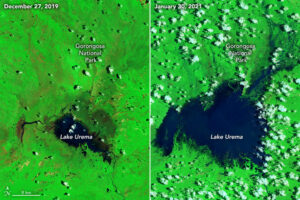Flooding continues to affect many flood plains and surrounding areas across Southern Africa, with damage to property including but not limited to homes, assets, livestock and farm land as well as fatalities reported over the last few weeks.
ZIMBABWE: The boarder town of Beitbridge is on high alert as continued heavy downpours of rain have caused flooding in the area. Watch video: pic.twitter.com/QdNvrf98We
— Apex World News (@apexworldnews) February 22, 2021
The Zimbabwean government has been carrying out evacuations of families settled in most low-lying areas and wetlands prone to flooding countrywide.
Four family members were swept away in Chiredzi after being marooned by heavy rains along Mutirikwi River.
They were part of eight people belonging to two Chiredzi families that were trapped midway when water levels rose while they were crossing the river.
In Gweru, Zimbabwe, flash floods followed a tragic incident where a vehicle with six occupants was swept away at the Gweru River bridge along the Gweru-Matobo Road.
The strong river currents have displaced aquatic animals too with several reports being made of crocodile and hippopotamus sightings in human settlements in rural and urban Zimbabwe.
Parts of South Africa were badly hit by flooding after heavy rainfall brought by Tropical Cyclone Eloise from around 23 January 2021.
Eloise has long since dissipated but heavy rainfall has continued to fall throughout the first weeks of February, causing further flooding and dam levels to rise. As of 11 February, authorities began releasing water from the Vaal Dam, situated about 75km south of Johannesburg.
The province of Mpumalanga was among the areas of South Africa worst affected by Tropical Storm Eloise.
On 04 February the government of Mpumalanga Province confirmed that 10 people had died “during the heavy rains that followed the tropical storm which reached the Province from 25 to 31 January 2021. Most of the fatalities were attributable to drowning as a result of the flooded rivers.”
Farms were damaged and hundreds of homes and roads were flooded in all districts of Northern Cape, in particular John Taolo Gaetsewe district where 3 people died according to the provincial government.
As of 12 February, many roads were still inundated and local media reported relief supplies were being delivered by helicopter. The Northern Cape government estimates that 600 million ZAR (around 40 million USD) is required for repairs to homes and infrastructure as well as for humanitarian and agricultural relief.
In late January 2021, Tropical Cyclone Eloise caused widespread damage and heavy flooding in central Mozambique. The storm displaced more than 16,000 people, damaged around 17,000 houses, and killed more than a dozen people across a few countries in southeast Africa.
These images show flooding on January 30, 2021, seven days after Eloise made landfall near the coastal city of Beira. The images from December 2019 are provided to compare the area under non-flooded conditions in the same season. The false color images, acquired by the Operational Land Imager (OLI) on Landsat 8, use a combination of visible and infrared light (bands 7-5-3) to help differentiate flood water (dark blue), bare land (brown), and vegetation (bright green).

Powerful storms and heavy downpours are battering people and economies harder, with the poor suffering the worst losses, an annual climate risk index showed, as leaders were urged to ramp up their response to climate change impacts at a global adaptation summit on Monday 25th of January.







